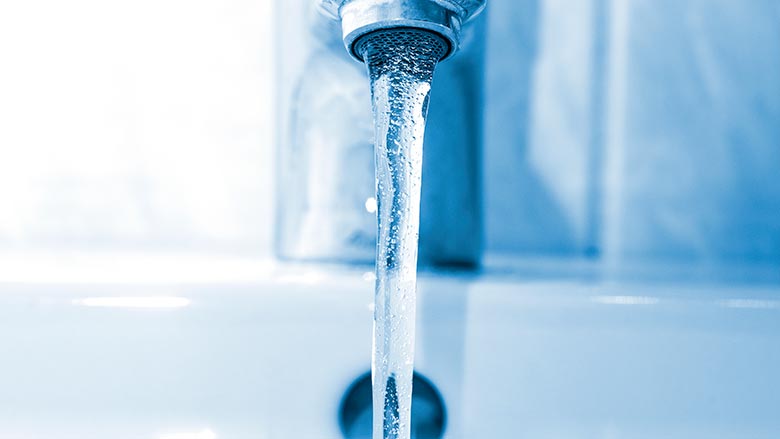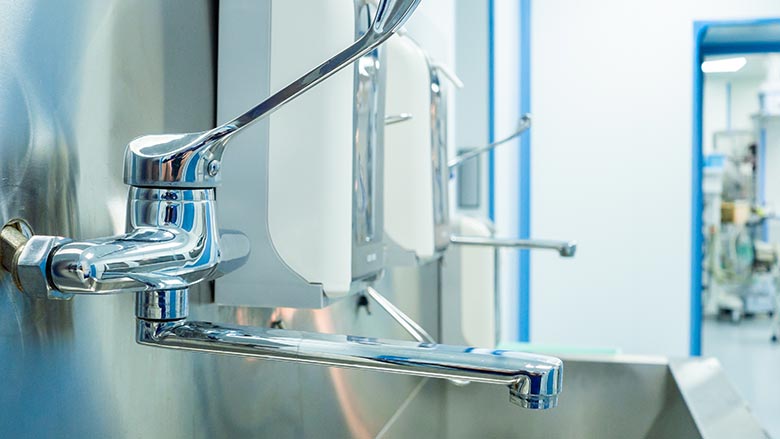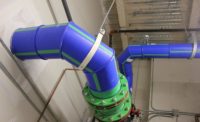With new and emerging water management standards, critical environments such as health care facilities must retool their systems and retrain their workers to provide better care quality and ensure patient safety throughout the built environment. When it comes to water, it is an all-hands-on-deck approach, as many teams and departments throughout these organizations either utilize water for procedures and tools or prepare these wet spaces for the immunocompromised patient population to temporarily reside.
One global leader in health care accreditation is paving the way with new and improved patient standards as it relates to the physical environment. The Joint Commission announced this year that it has added a new water management standard required for all TJC-accredited health care facilities, which went into effect Jan. 1. The Joint Commission is a not-for-profit organization intended to offer an unbiased assessment of patient care and safety while providing the health care facility with the accreditation needed to receive funding from the Center for Medicare and Medicaid programs (CMS). Its latest water management standard, EC 02.05.02, is comprised of four elements of performance and not only puts the spotlight on water quality but holds each facility’s feet to the fire to ensure that processes are followed for the safety of the patient. The emergence of these standards not only alerts us of the importance of water quality within a health care facility but also to the resources needed to maintain a safe and compliant environment.

Multidisciplinary team
The first element of performance to EC 02.05.02 includes the preparation of a robust, multidisciplinary team that can — and should — include members of the clinical staff, infection preventionists and biomedical experts, in concert with the facility operations team leaders. Forming the team is only one piece of the puzzle; education for team members on new and trending water safety topics will also be key. The water management teams in the health care environments are now accountable and required to conduct regularly documented meetings and audits of their programs as it pertains to both potable and non-potable systems. Many health care providers will be utilizing third-party consultants to assist with their plan authorship and management, but a few pioneer organizations are finding ways to perform this work in-house. Throughout the U.S., health care facilities have started employing plumbing industry professionals and subject-matter experts to lead critical systems maintenance programs and take ownership of new regulatory requirements.
Assessment of risk
The second element of performance requires each facility to conduct the most thorough risk assessment possible of each individual system, indicating the control points that provide systemwide adjustments to assist in the mitigation of waterborne pathogens. Key control points can be shown on a line diagram that clearly notates where within the systems those components reside and the areas that they serve. A control point for water safety can be a water heater, a mixing valve, or a pump system where adjustments to the system can be maintained, monitored, and validated for correct operation. Within the plan, each control point is to be listed with its operational parameters and frequencies for preventative maintenance protocols. Most importantly, this section of the plan will include corrective measures to be taken if control points were to stray from their building-specific operating parameters defined in the plan. Facility operations teams and engineers are being challenged to make documented adjustments to their systems, while ensuring the safety of the patient and efficacy of their plans, all in the effort to mitigate opportunistic waterborne pathogens.

Sampling and testing data
The third element of performance can shine a light on the plan’s effectiveness — the sampling and testing records. Depending on the requirements of the local AHJ, certain frequencies and testing parameters must be maintained. Along with the approved laboratory chain of custody, corrective action paper trails and any additional resample results must live within this element of performance in sequence. Baseline system data should be collected from distal outlets and source water points, as well. Capturing temperatures at both first draw and flush draw, concentrated levels of free chlorine, and PH markers can all give dimension to the systems being monitored. The main function of this element of performance will be to provide full context of any water quality issues and documentation of remedies when prescribed by system maintainers.
Tracking major breaches and modifications
The fourth and final element of performance tracks all major breaches and modifications made to the individual systems. Water management plans must include shutdown/startup protocols and stagnant water mitigation tools that a building can utilize when making modifications to the existing systems. The documenting of these changes not only helps the systems maintain historical records but also may indicate changes made that could affect proper sampling frequencies. For example, if the hospital adds a wing that serves hematopoietic stem cell transplant or solid organ transplant patients, it is highly likely that your plan must be adjusted for this highly immunocompromised patient population and additional mitigation tools must be deployed. Such additional mitigation tools can consist of environmental sampling being performed more frequently, to a showerhead cleaning or replacement program that may be utilized for that specific patient group. Infection preventionists rely heavily on the tracking of building activities as it relates to water. Infection prevention and control programs will undoubtedly expand in this effort through the Centers for Disease Control and Prevention’s (CDC) Water Infection Control Risk Assessment (WICRA) plans and the infection prevention and control team’s involvement in the water management team. Tasking health care facilities to find tools to track these activities that are not very easily communicated or documented will without question provide a safer environment for patients and building occupants.
Author’s experience
Not long ago, I worked as a corporate manager of plumbing programs at a multi-campus academic medical center in New York City. This was where I first heard of The Joint Commission’s newfound interest in water programs and dug right in on the preparation and implementation of each individual campus plan in accordance with TJC’s new standard. Preparing these plans with the help of each campus team was an arduous task, as we traced systems built so many decades earlier. Investigations were conducted throughout these historic campus buildings and areas of risk were documented with the goal of delivering a fully illustrated picture of operation during a formal TJC audit. The time spent on the preparation and education required of this new readiness routine led to substantial improvements to the built environment programs, and therein lies the purpose of these new standards. The plan preparation and interdepartmental team-building required was an eye-opening experience and shed light on some areas of neglect that some facilities may have had for years, prior to this new standard. While much of this may be new for many health care organizations throughout the country, places like New York City have been trailblazers in this effort for quite a few years due to their local health department requirements being some of the strictest in the nation. To be clear, The Joint Commission did not ignore water quality before. They most certainly made mention of it before with the EC 02.05.01 EP 14 standard, which contained a sole requirement to minimize “pathogenic biological agents in cooling towers, domestic hot- and cold-water systems, and other aerosolizing water systems.” This time the standard is robust and requires facilities teams to step out of their comfort zones and integrate departments like never before — all in the name of water quality.

Why education is critical
The task at hand is large and the results may not always tell us what we want to hear, but understanding what to look for and how to educate building owners and managers will be something for which we know patients and building occupants will be thankful. With new online education courses like the ASSE/IAPMO/ANSI 12080 “Legionella Water Safety and Management Specialist Certification Training,” certified personnel are well equipped to perform effective risk assessment analysis and develop water management sampling plans to protect from Legionella pneumophila and other opportunistic waterborne pathogens. The 12000 series, “Professional Qualifications Standard for Water Management and Infection Control Risk Assessment for Building Systems,” is an ANSI-accredited standard and provides comprehensive required training needed for tradespeople and maintenance personnel alike to form or lead a hospital water management team.
With all of the current gaps that exist in building water systems operation guidance, this program sheds light on the need for educated analysts and operators to help maintain these critical utilities. While no one specific standard will tell you how to run your management plan or when to sample, this 24-hour training course demonstrates the various modalities one can take to get ahead of the inevitable with real stories told by professionals. It provides comprehendible disinfection techniques being used industrywide, with peers from the industry as your virtual classmates. With ASSE/IAPMO/ANSI 12080 becoming the qualifying standard in building water systems safety, it’s starting to make its way into the front end of development projects as well. With topics discussed like “Preventing Legionnaires’ disease during construction and renovation,” the industry-wide conversation continues, helping others understand the value of properly adhered-to and well-formulated guidelines for installers to help stop these outbreaks shortly after a new project or renovation.
As advocacy increases for public water standards, whether in health care facilities, commercial spaces or residential, it is important to be progressive in sampling and testing requirements. If you or your team are considering authoring your own water management plans or hiring a third-party consultant, make sure they are equipped with the 12080 certification. With a trusted name in plumbing education like IAPMO, your certified water management teams will have the reputation and skills needed to better serve public health.
Virtual training is being offered by Special Pathogens Laboratory President Janet E. Stout, Ph.D., and can be found at IAPMOlearn.org along with a library of relevant training and CEU programs provided by the International Association of Plumbing and Mechanical Officials (IAPMO). During this multi-day online course, one can undergo in-depth training with Dr. Stout and her team of experts on how to write and implement water management plans to better serve the buildings we seek to protect.
For more information about the Legionella Water Safety and Management Specialist Certification Training, visit https://iapmolearn.org.



